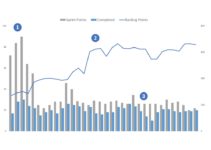Congratulations, you’ve made it. You have a budget, an emergency fund, a plan for your debt, and now you’re ready to start investing. If you don’t have any of these things, I recommend starting with those steps before you delve into investing. But now that you’re here, let’s talk about investing money – for beginners.
Note that this is a US-centric blog, because that’s what I know at this point. As I learn more about what investing looks like in Germany, I’ll update you!
What is investing?
At the most basic level, investing is letting somebody else use your money to do business. If the business does well, you get your money back plus a little extra. By that definition, a savings account at a bank is an investment. You give the bank your money, they do their business, and in return, you get it back, plus interest. Owning a rental property is investing. You let someone else use your house, and they pay you a set amount of rent.
But stocks and bonds are about as far as we need to go when talking about investing money for beginners Any investment strategy will use both of these types of investment because they react differently to world events.
Bonds
Bonds are how corporations and governments raise money for large projects. When you purchase a bond, you’re lending them a set amount of money (principal), with a set interest rate (coupon) and a date when you’ll get all that money (maturity date). A bond is different from a stock in how it shows up on a company’s balance sheet. A bond is a loan to the company/government, while a stock is a piece of ownership, or equity. (see here for more info on balance sheets)
Bonds are very stable investments – and therefore, have relatively low rates of return. But the stability makes bonds really useful as you get closer to retirement. If you want to be able to depend on the money being there, a stable investment is the way to go.
But bonds don’t just have to be for retirement. I had a high school teacher who bought his daughter a bond when she was young, with a maturity date when she was 16. He earmarked the money for a prom dress. I thought it was a really cute idea.
Stocks
When you invest in stocks, you are buying a small part of ownership in the company. In return for fronting the money, the company will either distribute profits to the stockholders through dividends or dedicate that same profit to building the company, driving up the share price and increasing the chance of the stockholder making a profit when they sell the stock.
Stocks are volatile. Stock prices change by the minute and they move erratically. I mean, you saw what happened in 2008 – and economists famously failed to see it coming. There is a chance of making a lot of money on a stock – and a chance of it going completely bust. That’s why the stock market is called “risky”. But there are ways to mitigate that risk.
Funds
One of the most common ways to mitigate the risk of the stock market is to buy funds instead of individual stocks. A fund is just a bucket of many different stocks. By having a bundle of them, if one goes bust, the others might hold their value, so it’s a safer investment.
There are lots of different kinds of funds out there.
Index funds have a representative sample of the entire stock market, so their value moves with the whole stock market.
Target date funds are a really common retirement investment. The rule of thumb is to hold more stocks when you’re far from retirement and move into bonds as you get older. Stocks when you’re young, to take advantage of the possibility of hitting a big win (and if you lose big, you have time to make it up). And bonds as you get older and need to depend on the income. When you buy a target date fund, it will automatically drop stocks and pick up bonds as it gets closer to the date – which is your intended retirement date.
Specialty funds invest in a specific type of company – like green energy. You would buy these if you want to ensure you’re investing is in line with your social or ethical values.
There are a bunch of different kinds of funds – here’s an article listing some more kinds. But as far as investing money for beginners go, just know that they’re a bucket filled with stocks and bonds.
Getting your money into investments
Ok, so now that you know the different things that you can invest in…how do you actually buy that stuff?
Simply: open an investment account, transfer your funds into the account, then buy stocks, bonds, or funds. You can do this through a large brokerage, like Vanguard or Fidelity, through a robo-advisor, like Betterment, or an app like Robinhood or Acorns.
And just like that, you have investments! From here, the mantra is, “time in the market beats timing the market.” AKA: put your money in there and LEAVE IT. You’ll get the best results if you have a low-touch approach to your investments. If you want the thrill of stock picking, check out this article from Nerd Wallet and get outta here. I work hard to spend as much time on things I care about – and following the market is NOT one of those things.
There’s also a whole rabbit hole you can go into to optimize your investments. But this is investing money for beginners, so the cliffnotes are: pay attention to fees.
Tax-Advantaged (ahem, Retirement) Accounts
I would be doing you a huge disservice if I didn’t at least mention taxes. When you get money back from an investment, you will owe taxes on it. I won’t go into the nuances of short-term vs. long-term capital gains taxes, but this is another reason why I prefer a low-touch investment strategy.
But there are certain types of investment accounts you can use to make taxes simpler for retiring.
401(k)
A 401(k) has to be sponsored by an employer. The benefit of this account is that it’s a “pre-tax” account, meaning any money you put in this account will come out of your paycheck before taxes are paid. So when you get around to spending that money, you’ll pay taxes on it then. Often, employers will offer matching to whatever funds you put in a 401(k) and for the LOVE OF ALL THINGS GOOD TAKE ADVANTAGE OF THAT – IT’S FREE MONEY!
(I will note that, if you’re self-employed and don’t have access to an employer-sponsored 401(k), there are individual 401(k) or individual retirement account options, but I’m not super-familiar with them and won’t cover them here)
The drawback of this account is that, if you want to touch the funds before you’re 59 ½, you’ll pay a penalty. But once you reach that age, you can choose a lump-sum payout or regular payouts. Either way, you’ll pay income tax whenever you receive those funds.
There’s a limit to how much money you can deposit in a 401(k) on an annual basis, so pay attention to that. But if you have a 401(k) available to you, try and work toward maxing it out annually! You should invest all money you put in the account.
IRA
An Individual Retirement Account (IRA) comes in two flavors – traditional and Roth. Either of these accounts can be set up by an individual with a broker. Like a 401(k), they have annual contribution limit and some strings attached if you withdraw before age 59 ½.
The difference between the traditional and Roth IRA comes in the timing of income tax. A traditional IRA operates like a 401(k) – you don’t pay income tax on money when it’s deposited in an IRA, just when you withdraw it. For a Roth IRA, you contribute money AFTER you’ve paid income taxes on it, so you don’t pay taxes on it when you withdraw in retirement.
Note that if you make too much money, you might not be able to contribute to an IRA, so look into that before you open one.
Taxable Accounts
I’d highly recommend maxing out contributions to any available tax-advantaged accounts. But if you still have some cash to save and want to invest beyond those limits, the taxable account is the way to go! It’s just a normal investment account. You put the money from your paycheck (post-tax) into it, and any money you make off it is taxable under capital gains taxes.
I hope my babbling on investing money for beginners has been useful! Let me know if you have any questions!




